It wasn’t my idea.
Although I’m grateful to spend time with my beautiful wife and three kids – the latter known as The Backseat Mafia™ – cramming everyone into our 14-year-old Volkswagen and driving the 620 miles to our family cabin seemed like Armageddon On Wheels to me. So, I had to be lured in. And boy did Marie know what bait to use: I was promised that we could stop the car whenever along the route to do chair-spotting.
I also wonder where the true Norwegian stick chairs are. We’ve been woodworking for over 1,000 years. We built our country and tradition on wood. I’m sure we’ve got birch sap running in our veins. Thus, there are of course stick chairs being made here, too. Some of them, like the Windsor-inspired Budal Chair, are even considered classics. The problem is that none of them are genuinely Norwegian in either form and origin. So I thought I’d start looking for them, and this trip seemed a good way to kick it off. Here are some of the chairs I encountered:
128 miles from home: Dalen, Telemark
In the traditional region of Telemark lies the small village called Dalen. We stopped here to visit the museum for Norwegian sculptor Anne Grimdalen. Part of the permanent exhibition was a display of her personal belongings. And among them was this staked Brettstuhl. Although the ornamental style of painting is almost quintessentially Norwegian, this is the first time I’ve encountered a chair like this in Norway.
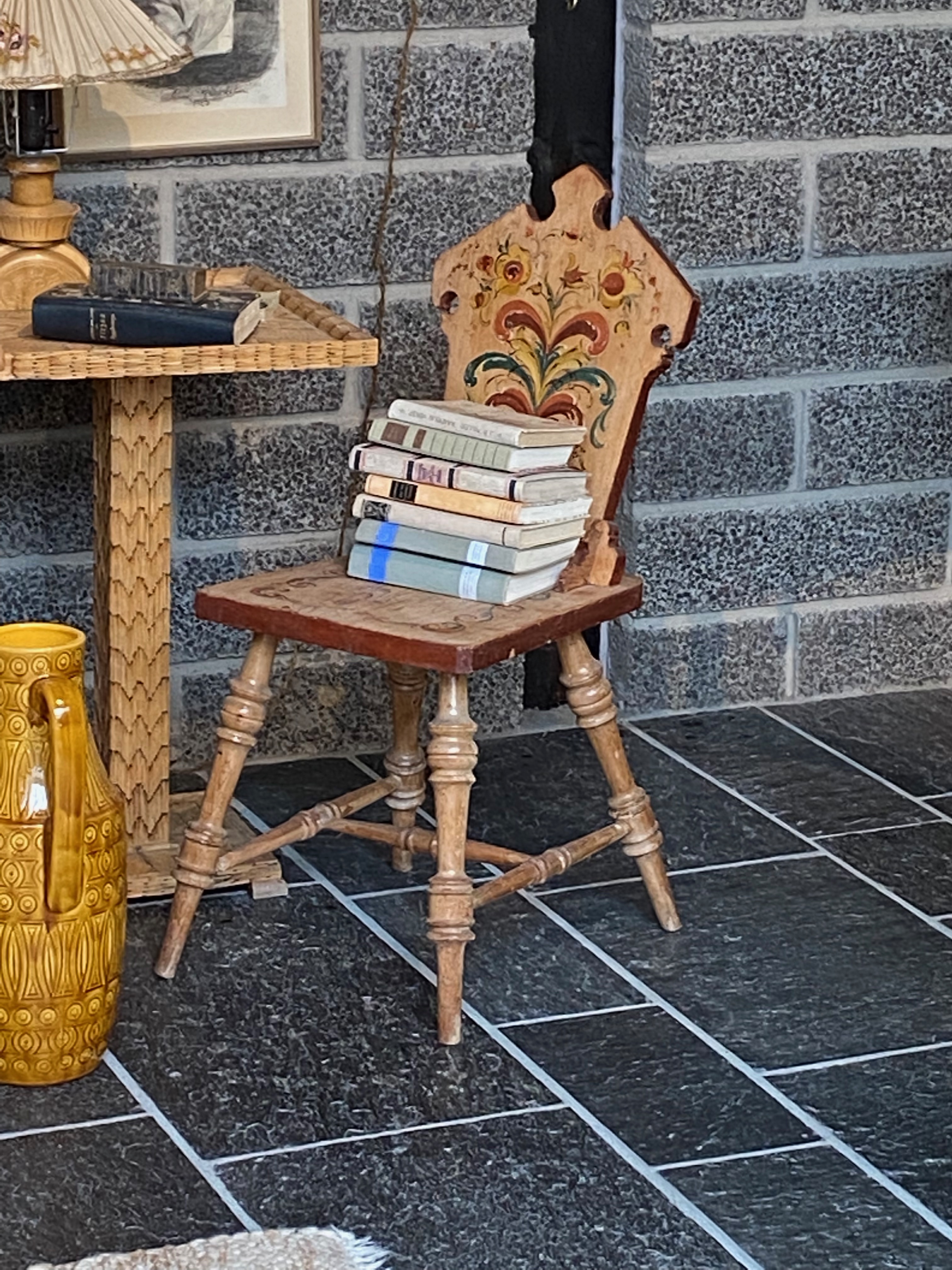
This type of chair is more common in Germany and some surrounding countries. I don’t know much about them, so I got in touch with my buddy and fellow Chair Chatter™, Rudy Everts, who knows more:
Rudy: This is an odd one…. The interesting thing about this chair is that it looks like a Brettstuhl but the construction is different. The first thing I noticed was the stretchers, these are very uncommon for a Brettstuhl to have. In fact it might be the first one I have ever seen with stretchers!
When you look closer, you see the seat is thicker than a normal Brettstuhl and it lacks the cross battens that are so typical for these chairs. So the maker constructed it like a normal stick chair. And added stretchers.
The design definitely draws its inspiration from the Germanic Brettstuhl, but with its own twist. The shapes are more straight and the ornamentation more “Nordic.” A Brettstuhl often has round details in the backrest, flower motifs and so on. And there is usually a hole in the back rest to pick up the chair when not in use. Therefore I would say the chair was made there locally and not imported from the Germanic countries and painted afterward.
454 miles from home: Alvdal, Hedmark
Back on the road again. Next stop: The village of Alvdal, which is another very historical place. The oldest pair of skis known to man was found here, dated back to the year 600. We came here to visit a museum. And while my family went to see the main exhibitions, I scoured the building for chairs. The first one I stumbled across was this one. A freak of nature, begging for attention.
I’m really not sure what to think of it. Except that it looks like a giant insect. The low seat and short back could indicate it being a children’s chair. But that’s hard to say. Although this doesn’t look like the typical fireside chair, history is full of low chairs made for different uses
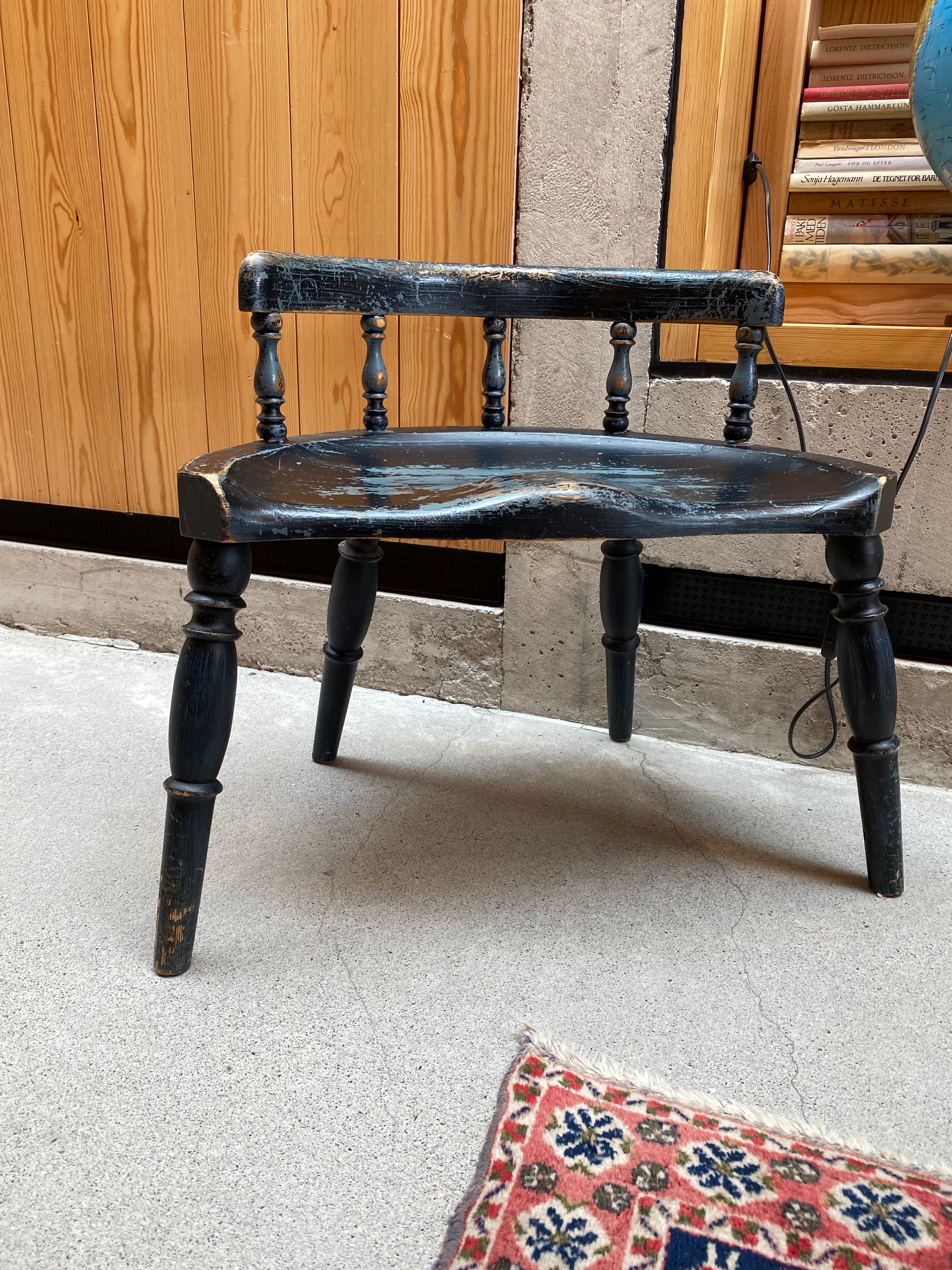
Each of the four legs are placed at the very edge of the seat. Combined with only a minor splay, this makes the stance of the chair clumsy to me. This combination is however not uncommon. English West Country chairs often look like this. Although it looks more balanced in a full size chair. Here it just looks a a bit wrong to me eyes. Kinda cute, but definitely more weird than wonderful.

So, I went to the café and got myself an overpriced cup of lukewarm motor oil labeled as coffee. Feeling robbed and unwell I looked for a place to sit, when lo and behold, this three-legged charmer made its appearance. Hand planed surfaces, octagonal legs and nicely worn original paint – what’s not to like? The large bevel around the half moon shaped seat also adds elegance. Though I would normally place such a bevel on the underside to make the seat appear lighter and thinner. Then again, it’s exactly these variations and improvisations that make the stick chair form so exciting to me. There’s often an element of surprise. Sometimes it works, sometimes it don’t.
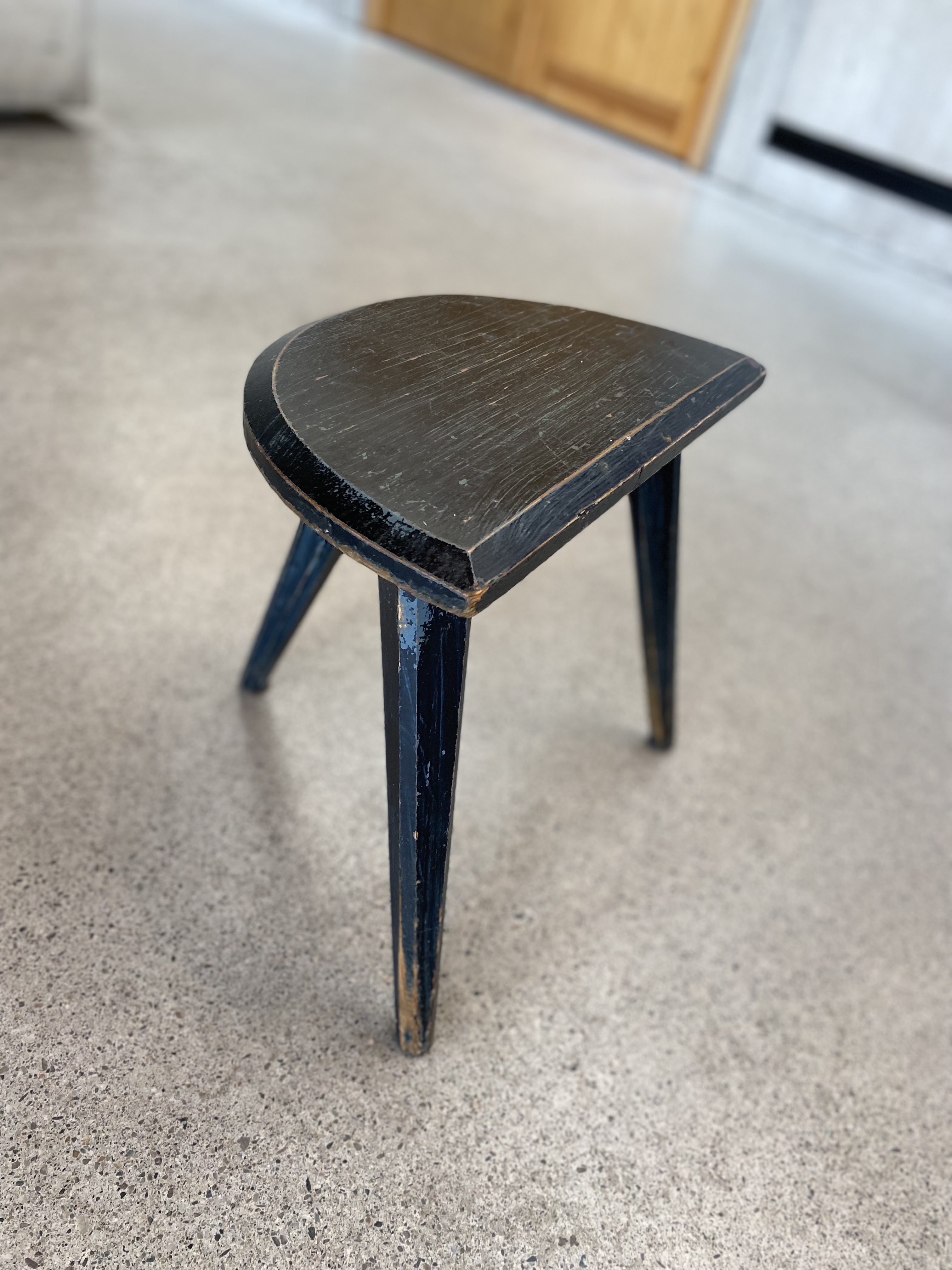
The rest of the construction was also unusual. Instead of mortising the legs through the seat, they were mortised into three separate battens that were screwed onto the underside. That at least tells me the stool wasn’t hastily put together by a farmer who needed a seat.
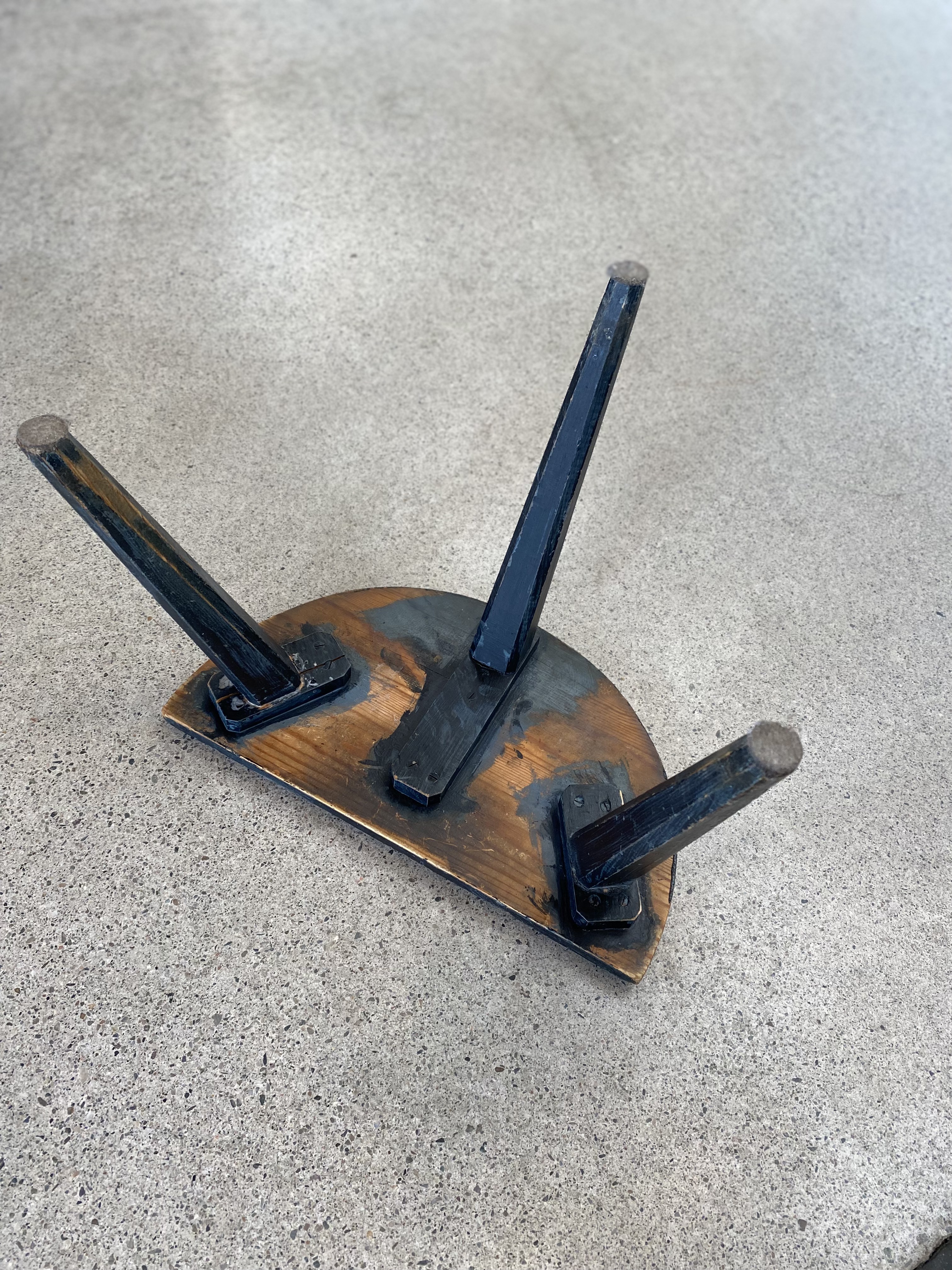
Two hours and three ice creams later we all cramped up in the car again and went to find a place to put up our tents. We found a pretty decent spot and called it an early night.
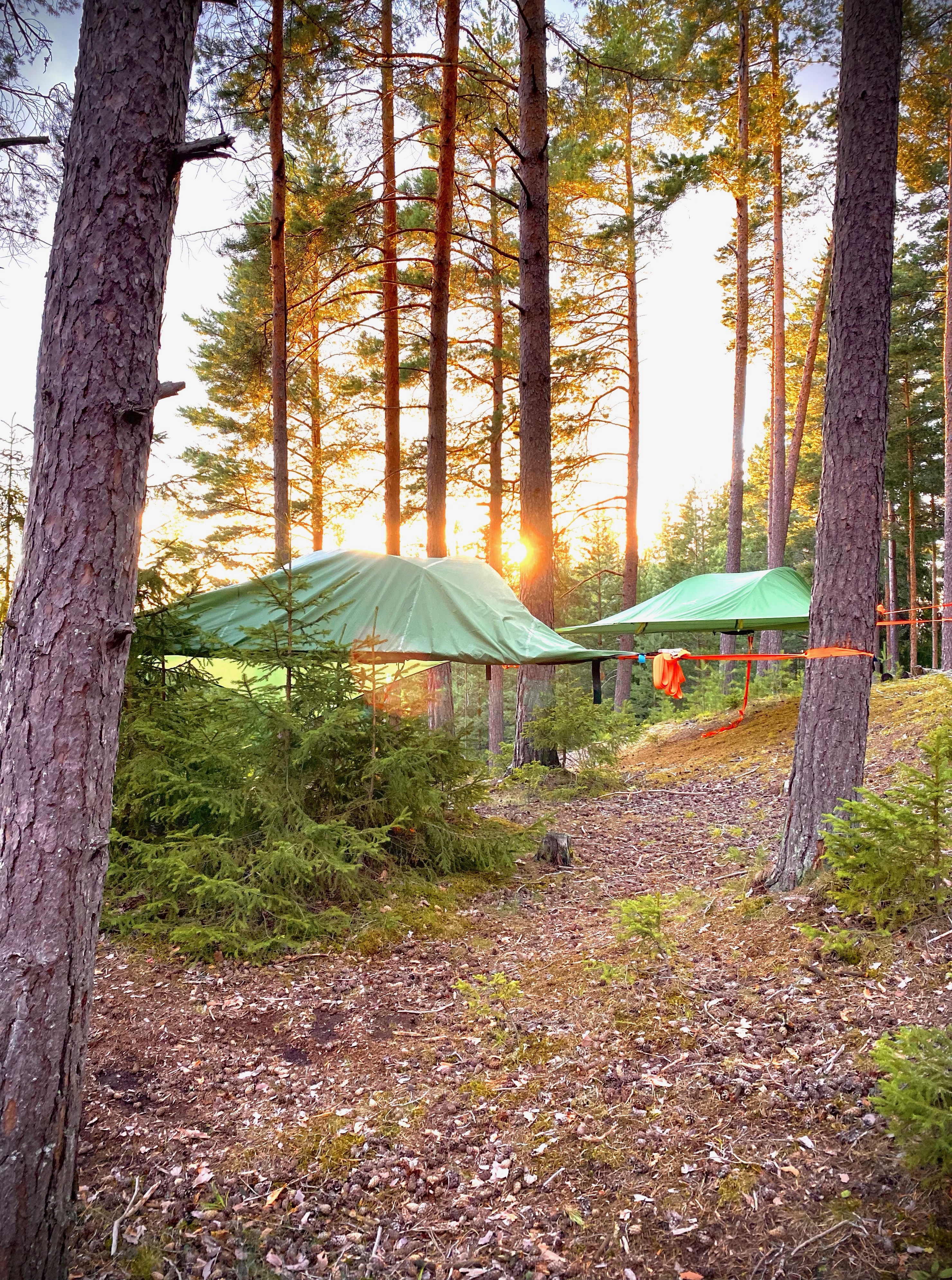
The next morning we rose early. After coffee, bread and brown cheese we hit the road again. I encountered even more vernacular chairs during the following days and miles on the road. Some of them were even not weird at all, just plain beautiful, with some interesting stories to them also.
I’ll share them with you in part two. For all of these and future chair encounters, I’ve set up an Instagram account for you to follow. As always, please share your thoughts and comments on these chairs or chairs you’ve encountered yourself!

My wife and I lived in Oslo for a year in 1995/1996. I miss gjetost for breakfast!
That’s cool! Oslo is a great city! And it sounds like you were quickly assimilated too… brown cheese for breakfast is as Norwegian as it gets! Can’t you get it somewhere? There must me some in Minnesota at least?!
Great news! I thought my local market stopped carrying Ski Queen gjetost years ago. But after reading your post (and having a serious craving) we did some careful searching and realized that they moved it to a different department. Guess what I’m having for breakfast tomorrow!
Which reminds me of a great riff from an MSTK short about skiing in Norway. At one point the narrator says “in Norway they pronounce it ‘sheeing’. And Joel says “you’re full of skit”.
That should say “MST3K” of course.
It’s good that you brought your kids along on the Great Chair Hunt. If you find a nice one you can use them as barter.
Great idea! I could never bring them to Wales. I would be a lonely man immediately after crossing the border.
Not to take away from the chair discussion, but what kind of tents are those?
No worries! Those are the Tentsile Stingray 3-person hammock tents: http://www.tentsile.com
Interesting post. It’s nice to see what’s out there in your part of the world.
Thanks, Pascal! Glad to hear you say that. There are so many great and interesting chairs out there in the wild! I’ve been collecting them for a long time, but it was about time to share some!
You seem to have confused what is obviously a beautiful and unique book case with a Brettstuhl. Perhaps the design of one was derived from the other though.
First : Heia Norge !
(That’s ‘Huzza Norway !’ for those lesser mortals who don’t speak Odin’s own language)
Being a poncy cabinetmaker by trade my conceptions of Norwegian chair-making traditions are hazy at best, but I always thought the ‘kubbestol’ was the closest we got to an imported idea of a native chair.
Or… let’s be honest: the genuine, Norwegian chair / bench is a wind-fallen tree trunk in the forest. It’s warmer than a stone.
( https://www.google.com/search?q=kubbestol&newwindow=1&client=firefox-b-d&source=lnms&tbm=isch&sa=X&ved=2ahUKEwjK7ZmG_6HyAhUCmIsKHR32Bo8Q_AUoAXoECAIQAw&biw=1408&bih=652 )
And what about the ‘høgsete’ mentioned in the Sagas ?
Looking forward to part 2, Mr. Skrudland 🙂
Heia Norge, Paulsen! Well, it’s funny you should mention the “kubbestol”, because Chris showed me a Swedish one earlier today. They’re definitely one of the oldest and most primitive chair forms we have here, you’re right about that. I have to admit I never really found them very interesting, but I guess I’ll have to start looking into them more. That said though, what I’m really after is a genuine, native Norwegian stick chair. The stick chair is such a primitive and rudimentary way of constructing a chair that I have trouble understanding why there are so few here.
Interesting thought about the “høgsete”, I’ll look into that too. Thanks for commenting!
This was awesome! Great work Klaus!
Thanks so much, Tony!
This great and fascinating! Can’t wait for part two!
Glad to hear that, Kyle!
That chair with a very low back is a common old Swedish form. It is used to change shoes in an entry hall. Similar to a tabourette.
Hey, sorry for the late reply. That’s very interesting to hear. I’ve never seen this type of chair before. I would love to know more about the chair if you have anything to add. Do you know what it’s called? Feel free to get in touch with me on email: lapsklaus@gmail.com Thanks!
I have to admit, chairspotting is not something I usually think about, but you drew me in with the title reference to Norway, and it was an enjoyable read! I had to smile at the mention of brown cheese, as I have a block of it in my fridge here in Arkansas right now. Always bring back fond memories of time with our friends in Holmestrand years ago.
Well, we all keep our eyes open for different things, I guess! I’m glad you liked it anyway! And it is SO awesome to hear that you’ve got brown cheese in your Arkansas fridge!! We drove through Holmestrand on our way home from this place. Even had a burger there! Not with brown cheese though… Thanks for your comment, Jason!